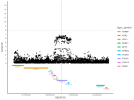Blog: DecodeME: the biggest ME/CFS study ever
The first results of DecodeME are in, the largest research project ever undertaken on myalgicContinue readingDecodeME: the biggest ME/CFS study ever

mecfsscience.org
Really good blog, as always
@ME/CFS Science Blog
Some minor issues, comments and suggestions:
“Human DNA has 3.2 billion of these ‘base pairs’, but most of them are not relevant or the same in everyone.”
Human DNA has 3.2 billion of these ‘base pairs’, but most of them are the same in everyone or not relevant.
[Avoids ambiguity]
“If your data doesn’t include the top SNP, you can check one of the SNPs nearby that is highly correlated with it.”
Not quite sure what this means. What is “your data”?
“Humans have around 20.000 to 25.000 genes.”
20,000 to 25,000 not 20.000 to 25.000
“In the graph, we use the -log10 of p-values, so the higher on the plot, the lower the p-value, and the more unusual the SNP.”
Long dash without space (–log10) or write negative. I was confused because on my screen there was a line space between the - and log10. The graph should also indicate this.
“Indeed, the difference in prevalence of SNPs hits is only about 1% to 2% between patients and controls.”
I think you mean percentage points. The difference between 34% and 32% is 2 percentage points but approximately 6%.
“A recent
paper in Nature backs this up. It examined data on drug development and found that effect sizes from genetic studies did not influence the chance that a drug will be successful.”
Perhaps make it clearer that you mean the size of the effect doesn’t matter, providing there is an effect.
“With another tool called ‘LD Score Regression (LDSC)’, we can also look at the genetic correlation between ME/CFS and other diseases registered in the UK Biobank.”
You use capitals so the inverted commas are redundant.
“There were substantial correlations with many illness categories, especially those related to gut problems, fatigue, pain, and depression.”
I thought the pre-print suggested there was no overlap with genes associated with anxiety or depression. I’ve not managed to keep up with discussions. Is that now considered to be inaccurate?
“There were also significant correlations with schizophrenia (rg = 0.53)”
I didn’t know that. I wonder if ME/CFS could tell us something useful about the mechanisms of schizophrenia.
“Lastly, DecodeME also provided an estimate of the heritability of ME/CFS, which was 9.5%”
I wonder if you should have explained what heritability of 9.5% means.
“DecodeME also looked at the common SNPs only where the frequency of the minor allele was 1% or higher.”
Also, DecodeME only looked at the common SNPs where the frequency of the minor allele was 1% or higher.
Thanks again. I’m looking forward to reading your next blog.



